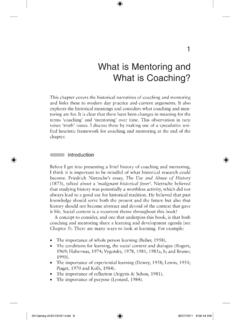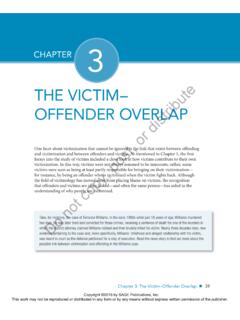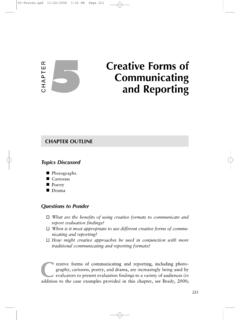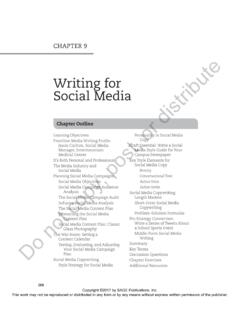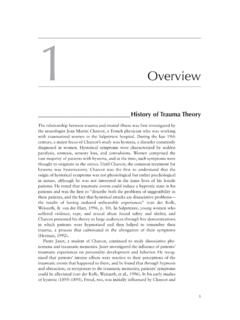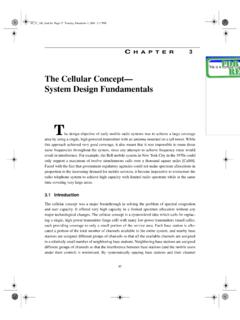Transcription of THE CONCEPT OF CULTURE
1 9 This treatise on the study of cross-cultural differences between mod-ern societies starts with an examination of the various ways in which CULTURE has been conceptualized. Approaches to the CONCEPT and study of CULTURE have varied between academic disciplines, and some-times even within them. The goal of this analysis is not to provide one right perspective. CULTURE can be whatever a scholar decides it should be. What we need is not a single best theoretical definition of CULTURE but clear empirical operationalizations of each approach: Researchers need to explain exactly how they propose to measure CULTURE in accordance with their conceptualizations, diverse as they may be. 1 THE CONCEPT OF CULTURE 10 Understanding CULTURE The Unpackaging of CULTURE Psychologists who compare individu-als from different nationalities or ethnic groups often observe differences between them on the dependent variables that they study.
2 In such cases, they may show that various psychological variables, as well as age, gender, educational level, and more, produce a statistical effect that seems to account for the differences. But what if some of the variance remains unexplained? In that case, it was common practice until recently to refer to an obscure residual called CULTURE . Originally, the CONCEPT of CULTURE seemed even more opaque to researchers who compared organizations in different countries. In the words of Child (1981), In effect, national differences found in characteristics of organizations or their members have been ascribed to .. national differences, period (p. 304). To a cultural anthropologist, CULTURE is neither obscure, nor a residual. It is a social phenomenon that manifests itself quite clearly, even if the manifestations are not always easy to explain. Anthropologists consider CULTURE an important phenom-enon that warrants its own field of study.
3 They do not view it as a single variable; being an extremely complex system, it is to be analyzed in terms of its components and their relationships. Although cross-cultural psychologists and organizational behavior experts accepted this logic rela-tively late, by now they too have grasped the need to unpackage CULTURE rather than approach it as a monolithic block. 1 This chapter and the next prepare the reader for the third one, which represents an unpackaging exercise. We must start with a philosophical warning at the very outset of our journey. We will not try to find out what is in the package because that would be futile. CULTURE is not a specific material object that has its own objec-tive existence. It is underpinned by real phenomena that, however, we perceive and analyze subjectively. Therefore, the best that we can do in a discussion of the nature of CULTURE is to explore the subjec-tive conceptualizations of various schol-ars.
4 Then, we can discuss the contents of the package labeled CULTURE as they have been seen by cross-cultural experts. Meaning of the Word CULTURE and Definitions of the CONCEPT The origin of the Latin word cultura is clear. It is a derivative of the verb colo (infinitive colere), meaning to tend, to cultivate, and to till, among other things (Tucker, 1931). It can take objects such as ager, hence agricultura, whose literal meaning is field tilling. Another possible object of the verb colo is animus ( character ). In that case, the expres-sion would refer to the cultivation of the human character. Consequently, the Latin noun cultura can be associated with edu-cation and refinement. The etymological analysis of CULTURE is quite uncontroversial. But in the field of anthropology, the situation is much more complex. Definitions of CULTURE abound and range from very complex to very simple.
5 For example, a complex definition was proposed by Kroeber and Parsons (1958): transmit-ted and created content and patterns of values, ideas, and other symbolic- meaningful systems as factors in the shaping of human behavior (p. 583). An even less easily comprehensible definition was provided by White (1959/2007): By CULTURE we mean an extrasomatic, temporal continuum of things and events dependent upon symbol-ing (p. 3). Often cited is also a definition by Kluckhohn (1951): CULTURE consists in patterned ways of thinking, feeling and reacting, acquired and transmitted mainly by symbols, constituting the distinctive achievements of human groups, including their The CONCEPT of CULTURE 11 embodiments in artifacts; the essential core of CULTURE consists of traditional ( historically derived and selected) ideas and especially their attached val-ues.
6 (p. 86, no. 5) But that is not all. Geertz (1973) noted sarcastically that in some twenty-seven pages of his chapter on the CONCEPT , Kluckhohn managed to define CULTURE in turn as .. [what follows is 11 differ-ent definitions]; and turning, perhaps in desperation, to similes, as a map, as a sieve, and as a matrix (p. 5). This lack of clarity and consensus about anthro-pologists main object of study may be one of the reasons that, in the words of Cochran and Harpending (2009), the social sciences and especially anthropology haven t exactly covered themselves in glory (p. ix). 2 It also explains why to many researchers and practitioners, CULTURE is the c-word, mysterious, frightening and to be avoided (Berry, 1997, p. 144). Some have even denied the utility of the CONCEPT (Barber, 2008b). At the other extreme is a well-known simple and narrow definition: CULTURE is shared mental software, the collective programming of the mind that distinguishes the members of one group or category of people from another (Hofstede, 2001).
7 The group or category can be a national society but Hofstede believes that his defi-nition applies also to other collectives, such as regions, ethnicities, occupations, orga-nizations, or even age groups and genders. According to Jahoda (1984), CULTURE is the most elusive term in the vocabulary of the social sciences and the number of books devoted to the topic would fill many library shelves. A practical solu-tion was proposed by Segall (1984), who believed that it was not worth the effort to enhance the CONCEPT s clarity or attempt to articulate a universally acceptable defini-tion. In his view, cultural analysts should abandon the struggle to conceptualize cul-ture. Instead, they should turn to the real business at hand, which is to intensify the search for whatever ecological, socio-logical and cultural variables might link with established variations in human behavior (p.)
8 154). Segall s call for pragmatism in cross-cultural analysis is laudable. Theoretical debates about the meaning that should be attributed to the CONCEPT of CULTURE are pointless. There is no absolute reason why one abstract theoretical CONCEPT of it should be better than another. However, disagreements have been voiced not only with respect to abstract definitions of CULTURE but also concerning specific mat-ters, such as whether artifacts should or should not be considered part of CULTURE (see the debate between Jahoda, 1984, and Rohner, 1984). The answer to a ques-tion of this kind can have practical conse-quences: It may determine what should or should not be studied for the purpose of a dissertation on CULTURE or be published in a journal devoted to CULTURE . CULTURE can be pragmatically defined by the contents and boundaries of the inter-ests of the scholars who study it.
9 Even bet-ter, we should look at what is in the focus of their interests. A culturologist may study climatic differences (for instance, van de Vliert, 2009), although climate is unlikely to be viewed by anybody as part of CULTURE . Yet, that researcher would not be interested in climate per se, but in how it affects variation in values, beliefs, and behaviors, which could be considered ele-ments or expressions of CULTURE . Defining the contents and boundaries of CULTURE may also be necessary for the purposes of clarity and avoidance of con-fusing statements. According to Jahoda (1984), if CULTURE is seen as including behaviors, it is incorrect to say that CULTURE causes behavior because that would be a circular explanation. Likewise, Fischer and Schwartz (2011) discuss the question of whether CULTURE determines values. This makes sense only if values are not viewed as part of CULTURE ; otherwise the debate would be like the question of whether light produces photons.
10 12 Understanding CULTURE Therefore, it might be useful that those who present cultural analyses explain how they conceptualize CULTURE , specifying its contents and boundaries. This could help avoid a situation described by Child (1981), who pointed out that there is a danger of inferring CULTURE as a national phenomenon from virtually any contrasts that emerge from a comparison of orga-nizations in different countries: Even if such contrasts are unambiguously national in scope, they could possibly be due to other non-cultural phenomena such as national wealth, level of industrialization, or even climate (p. 328). A comment by Fischer (2009) illustrates another practical reason to define CULTURE . In his view, if researchers do not focus on the shared aspect of CULTURE (see ), there is no need to investigate agreement among the members of a national CULTURE who provide information to a researcher.
